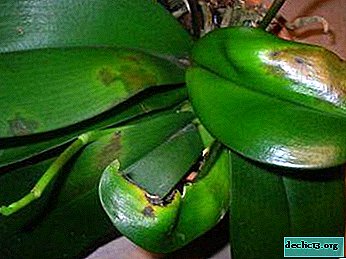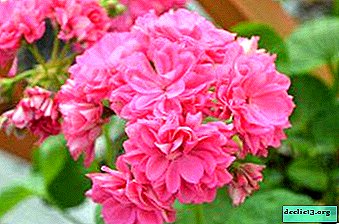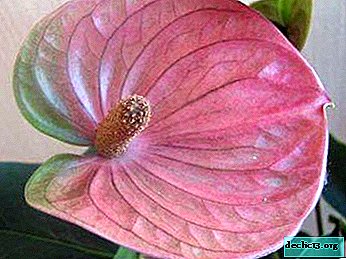The main reasons why phalaenopsis does not bloom

Tropical Phalaenopsis orchids conquer buyers with their lush, bright petals, but their flowering period often ends fairly quickly, and gardeners begin to look for ways to solve this problem. First of all, it is necessary to find out the reasons - perhaps they lie in improper care.
What we need this beautiful flower for flowering and how to avoid growing errors, we will tell in our article. We also recommend watching a useful video on this topic.
When and how does it bloom?
This type of orchid, unlike others, can bloom at any time of the year. The frequency and duration of phalaenopsis flowering directly depends on the conditions of detention: amount of watering and the content of minerals in top dressing, lighting and temperature in the room where the plant is located.
Typically, flowers appear twice a year, and sometimes thrice, and last from 2 months to six months. The petals of a blossoming phalaenopsis resemble the wings of an exotic butterfly, striking with a variety of shades - there are both monophonic (white, red violet, yellow), and with streaks, specks, spots. The diameter of the inflorescence is from 2 to 15 cm.
When to start worrying?
On average, the interval between flowering in phalaenopsis is about three months. Therefore, if after this period the plant does not bloom, it is worth paying attention to the conditions of detention.
Reasons for the lack of flowering
Long
A long (when 2 years have passed since the planting) absence of flowers from an orchid growing at home indicates an improper care or disease of the plant. Consider them:
 Pests. The plant can become a victim of parasites such as spider mites, scale insects, mealybugs, thrips. To combat them, an aqueous solution of laundry soap is used, which processes leaves and stems; in advanced cases, insecticides should be used.
Pests. The plant can become a victim of parasites such as spider mites, scale insects, mealybugs, thrips. To combat them, an aqueous solution of laundry soap is used, which processes leaves and stems; in advanced cases, insecticides should be used.- Disease. May be infectious and non-infectious. Most often manifested in rotting roots or unnatural spots on leaves and petals. The main reasons: excessive watering, low air temperature and high humidity in the room. Treatment is carried out by changing the substrate and treating the plant with a fungicide.
- Florist Errors. Lack of lighting, an overabundance of nitrogen-containing fertilizers can delay the flowering of phalaenopsis, but when eliminating errors in the care, the plant is again decorated with inflorescences. The cause of a long break after the growing season can also be the fatigue of the orchid - in this case, you need to give her time to recover, and then stimulate flowering.
The formation of flower buds depends on proper care at this stage, so it is necessary to regularly feed phalaenopsis with mineral complexes with a high content of phosphorus, magnesium and potassium.
Short-term
Please note that after a long flowering phalaenopsis needs a period of rest, during which the plant rests and forms new peduncles. In our climatic conditions, this most often happens in winter: daylight hours decrease, temperature drops, and for an orchid, accustomed to a stable tropical climate, this is stressful. Most likely, with the first rays of the spring sun, phalaenopsis will again decorate the house with its lush flowers.
How to determine the source of the problem?
 To understand why phalaenopsis does not bloom, you need to pay attention to the care and appearance of the plant. If the flower looks healthy and does not have any defects, the reason is probably due to improper conditions of its maintenance. In this case, the adjustment of lighting, fertilizer composition and air temperature at home should lead to the desired effect.
To understand why phalaenopsis does not bloom, you need to pay attention to the care and appearance of the plant. If the flower looks healthy and does not have any defects, the reason is probably due to improper conditions of its maintenance. In this case, the adjustment of lighting, fertilizer composition and air temperature at home should lead to the desired effect.
In most cases, the lack of flowering is only one of the factors indicating that something is wrong with the orchid. Other possible signs of disorders of care or illness: yellowing and wilting of leaves, the appearance of “rusty” spots or tubercles on them, rotting or drying of the roots. The methods of treating phalaenopsis diseases and controlling parasites have already been mentioned above.
Why create extreme conditions for the plant?
If the flower does not get sick and receives the right care, but the growing season has dragged on, it is possible to stimulate the flowering of phalaenopsis by creating extreme conditions.
TIP: You need to make sure that the plant rested from the past flowering and gained enough strength, otherwise it will simply die.There are 2 main methods for creating extreme conditions:
- Temperature changes. This method is applicable only in spring, when the air temperature at night warms up to 16 degrees. In the dark, the plant is taken out onto the street or a non-glazed balcony, returned to the house during the day or left on the street, but in the shade. Usually flowering occurs after 2 weeks of such procedures.
- Drought. The method is used only during the period of active growth of orchids. Recommended air temperature should not exceed 30 degrees. Reduce the watering of the flower - after drying the soil wait 3-4 days.
Watch a video on ways to make an orchid blossom:
Briefly about what to do
In the absence of flowering, first of all, it is necessary to make sure that the plant has completely grown, matured and formed peduncles. If the growth period has ended, and there are still no flowers, a thorough examination of the orchid is recommended for signs of disease, pests and disturbances in care.
After treatment and normalization of the conditions of detention, phalaenopsis will certainly please the owner with its beautiful flowers. And if the plant has a dormant period, you can use extreme methods to stimulate flowering (on how to make an orchid bloom, read here).
Conclusion
Subject to certain temperature conditions, balanced watering, proper fertilizer and adequate lighting Phalaenopsis orchid is able to please owners with exotic flowers almost year-roundlooking like butterfly wings.
But it should be understood that this plant needs regular care and does not forgive inattentive attitude. The optimal conditions for frequent and prolonged flowering of phalaenopsis are as close as possible to its natural habitat.

 Pests. The plant can become a victim of parasites such as spider mites, scale insects, mealybugs, thrips. To combat them, an aqueous solution of laundry soap is used, which processes leaves and stems; in advanced cases, insecticides should be used.
Pests. The plant can become a victim of parasites such as spider mites, scale insects, mealybugs, thrips. To combat them, an aqueous solution of laundry soap is used, which processes leaves and stems; in advanced cases, insecticides should be used.















